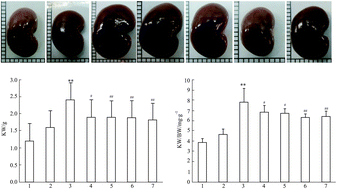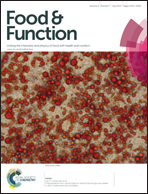Grape seed proanthocyanidins prevent DOCA-salt hypertension-induced renal injury and its mechanisms in rats
Abstract
Renal dysfunction is one of the major effects of DOCA (deoxycorticosterone acetate)-salt hypertension and there is an increasing amount of evidence that oxidative stress damages the function of the kidney. Grape seed proanthocyanidins (GSPE) have been reported to be potent anti-oxidants and free radical scavengers. The present study sought to investigate the ability of GSPE to prevent renal injury in DOCA-salt hypertensive rats and to explore the molecular mechanisms underlying its protective effects. A total of 54 Sprague Dawley (SD) rats were randomly divided into 7 groups: Sham group (n = 7), UnX-sham group (n = 8), DOCA-salt group (n = 8), GSPE150 group (150 mg kg−1, n = 7), GSPE240 group (240 mg kg−1, n = 8), GSPE384 group (384 mg kg−1, n = 8) and ALM (amlodipine besylate tablets) group (5 mg kg−1, n = 8), and treated for 4 weeks. Compared to sham group rats, renal injury was observed in DOCA-salt hypertensive group rats as the urine protein, KW/BW (kidney weight/body weight), degree of renal fibrosis, renal MDA (malondialdehyde) and Hyp (hydroxyproline) contents significantly increased (P < 0.01). Moreover, SOD (Superoxide Dismutase) activities decreased in the model group (P < 0.01). In contrast, DOCA-salt hypertensive rats treated with different dose of GSPE or ALM showed a significant improvement of renal injury with decreased urine protein, KW/BW, degree of renal fibrosis, renal total MDA and Hyp contents compared to the untreated group. In addition, SOD activities increased in the treatment group. Since the experimental modeling time was short, kidney damage occurs to a lesser extent. BUN (Blood Urea Nitrogen), Scr (Serum Creatinine) and UA (Uric Acid) contents did not appear significantly changed in all groups. Finally, the activation of JNK and p38 kinases in the kidney was suppressed in rats treated with GSPEs or ALM compared to the untreated group, suggesting that the inhibition of these kinase pathways by GSPE contributes to the improvement of renal function. Taking these results together, we conclude that the anti-hypertensive and anti-oxidative stress beneficial effects of GSPE on renal injury in rats with DOCA-salt hypertension occur via the attenuation of JNK and p38 activity.


 Please wait while we load your content...
Please wait while we load your content...